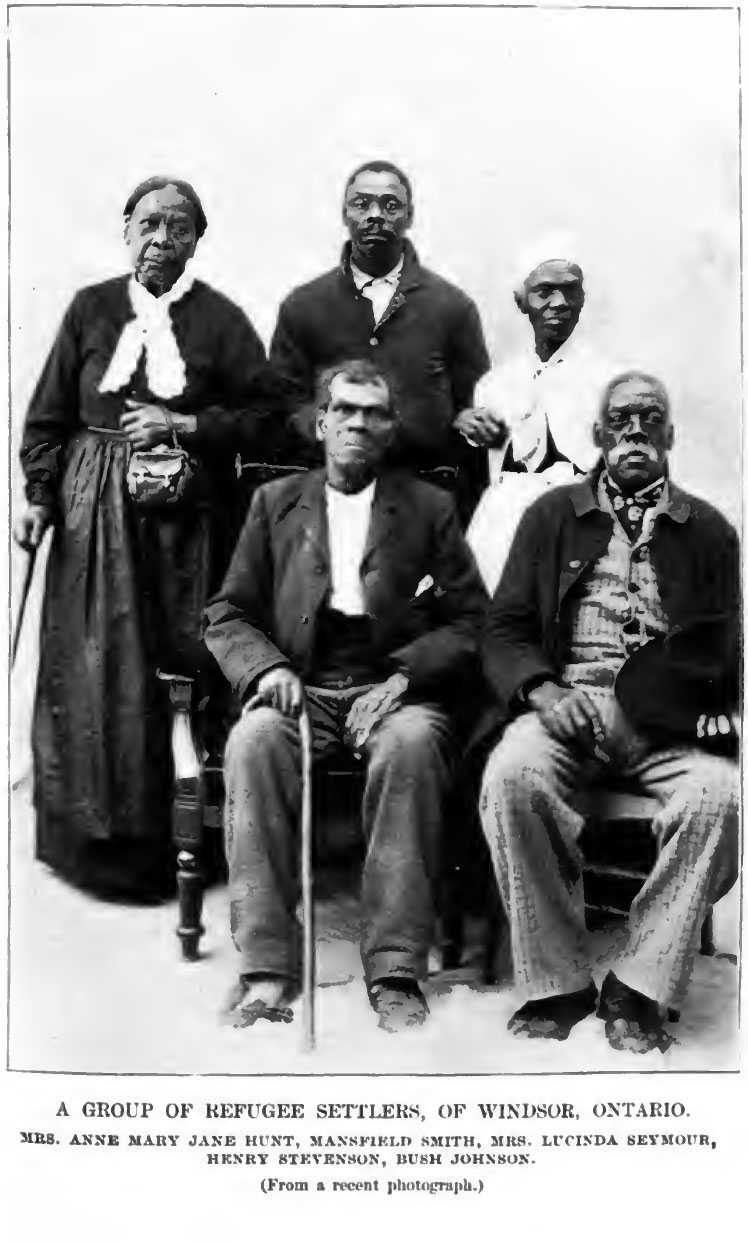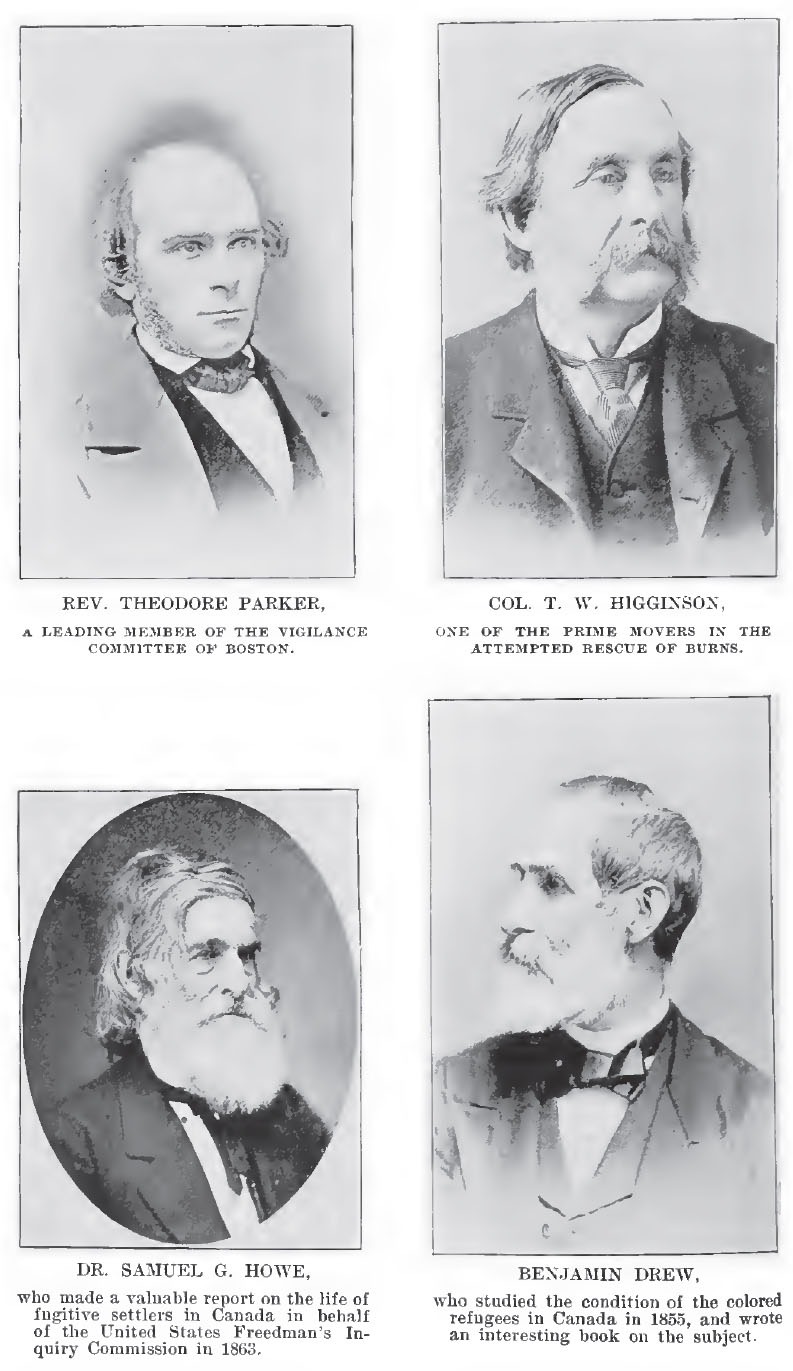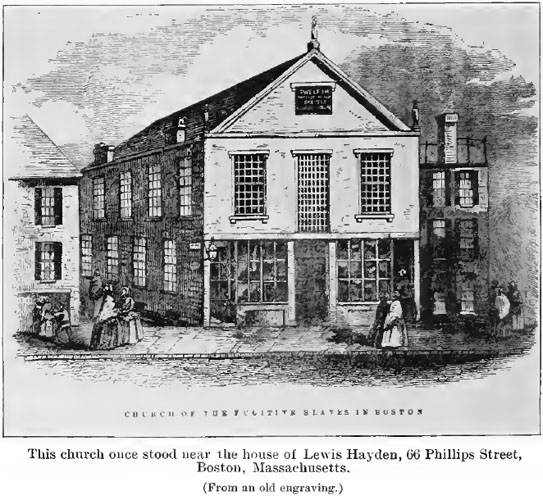|
CHAPTER VII
LIFE OF THE COLORED REFUGEES IN CANADA
Pg. 190
The passengers of the
Underground Railroad had but one real refuge, one region
alone within whose bounds they could know they were safe
from reënslavement;
that region was Canada. The position of Canada on
the slavery question was peculiar, for the imperial act
abolishing slavery throughout the colonies of England
was not passed until 1833; and, legally, if not
actually, slavery existed in Canada until that year. The
importation of slaves into this northern country had
been tolerated by the French, and later, under an act
passed in 1790, had been encouraged by the English.
It is a singular fact that while this measure was in
force slaves escaped from their Canadian masters to the
United States, where they found freedom.1
Before the separation of the Upper and Lower Provinces
in 1791, slavery had spread westward into Upper Canada,
and a few hundred negroes and some Pawnee Indians were
to be found in bondage through the small scattered
settlements of the Niagara, Home and Western districts.
The Province of Upper Canada took the initiative in the
restriction of slavery. In the year 1793, in which
Congress provided for the rendition by the Northern
states of fugitives from labor, the first parliament of
Upper Canada enacted a
---------------
1 "A case of this kind," says Dr. S. G. Howe,"
was related to us byMrs. Amy Martin. She
says: "My father's name was James Ford . . . . He
. . . would be over one hundred years old, if he were
now living . . . . He was held here (in Canada) by the
Indians as a slave, and sold, I think he said to a
British officer, who was a very cruel master, and he
escaped from him, and came to Ohio, . . . to Cleveland,
I believe, first, and made his way from there to Erie
(Pa.), where he settled . . . . When we were in Erie, we
moved a little way out of the village, and our house was
. . . a station of the U. S. R. R." The
Refugees from Slavery in Canada West, by S. G.
Howe, 1864, pp.8, 9.

A GROUP OF REFUGEE SETTLERS, OF WINDSOR, ONTARIO
MRS. ANN MARY JANE HUNT, MANSFIELD SMITH, MRS. LUCINDA
SEYMOUR, HENRY STEVENSON, BUSH JOHNSON.
(From a recent photograph.)
[Pg. 191] -
DISAPPEARANCE OF SLAVERY FROM CANADA
law against the
importation of slaves, and incorporated in it a clause
to the effect that children of slaves then held were to
become free at the age of twenty-five years.1
Nevertheless, judicial rather than legislative action
terminated slavery in Lower Canada, for a series of
three fugitive slave cases occurred between the first
day of February, 1798, and the last day of February,
1800. The third of these suits, known as the Robin
case, was tried before the full Court of King's Bench,
and the court ordered the discharge of the fugitive from
his confinement. Perhaps the correctness of the
decisions rendered in these cases may be questioned; but
it is noteworthy that the provincial legislature would
not cross them, and it may therefore be asserted that
slavery really ceased in Lower Canada after the decision
of the Robin case, Feb.18, 1800.2
The seaboard provinces were but little infected by
slavery. Nova Scotia, to which probably more than
to any other of these, refugees from Southern bondage
fled, had be reason of natural causes, lost nearly, if
not quite all traces of slavery by the beginning of our
century. The experience of the eighteenth century
had been sufficient to reform public opinion in Canada
on the question of slavery, and to show that the climate
of the provinces was a permanent barrier to the
profitable employment of slave labor.
During the period in which Canada was thus freeing
herself from the last vestiges of the evil, slaves who
had escaped from Southern masters were beginning to
appeal for protection to anti-slavery people in the
Northern states.3 The arrests of
refugees from bondage, and the cases of kidnapping of
free negroes, which were not infrequent in the North,
strengthened the appeals of the hunted suppliants.
Under these circumstances, it was natural that there
should have arisen early in the present century the
beginnings of a movement on thenorthern border of the
United States for the purpose of helping fugitives to
Canadian soil.4
---------------
1 Act of 30th Geo. III.
2 See the article entitled "Slavery in
Canada," by J. C. Hamilton, LL.B.
3 M. G. McDougall, Fugitive Slaves,
p. 20.
4 Ibid., p. 60; R. C. Smedley,
Underground Railroad, p. 26.
[Pg. 192]
Upon the questions how and when this system arose, we
have both unofficial and official testimony. Dr.
Samuel G.
Howe learned upon careful investigation, in 1863,
that the early abolition of slavery in Canada did not
affect slavery in
the United States for several years. "Now and then
a slave was intelligent and bold enough," he states, "to
cross the
vast forest between the Ohio and the Lakes, and find a
refuge beyond them. Such cases were at first very
rare, and knowledge of them was confined to few; but
they increased early in this century; and the rumor
gradually spread among the slaves of the Southern
states, that there was, far away under the north star, a
land where the flag of the Union did not float; where
the law declared all men free and equal; where the
people respected the law, and the government, if need
be, enforced it. . . . Some, not
content with personal freedom and happiness, went
secretly back to their old homes, and brought away their
wives and children at much peril and cost. The
rumor widened; the fugitives so increased, that a secret
pathway, since called the Underground Railroad, was soon
formed, which ran by the huts of the blacks in the slave
states, and the houses of good Samaritans in the free
states. . . . Hundreds trod this path
every year, but they did not attract much public
notice."1 Before the year 1817 it is
said that a single little group of abolitionists in
southern Ohio had forwarded to Canada by this secret
path more than a thousand fugitive slaves.2
The truth of this account is confirmed by the diplomatic
negotiations of 1826 relating to 0this subject.
Mr. Clay, then Secretary of State, declared
the escape of slaves to British territory to be a
"growing evil"; and in 1828 he again described it as
still "growing," and added that it was well calculated
to disturb the peaceful relations existing between the
United States and the adjacent British provinces.
England, however, steadfastly refused to accept Mr.
Clay's proposed stipulation for extradition, on
the ground that the British government could not, "with
respect to the British possessions where slavery is not
admitted, de-
---------------
1 S. G. Howe,
The Refugees from Slavery in Canada West, pp. 11,
12.
2 William Birney, James G. Birney and His
Times, p. 435.
[Pg. 193] -
INFLUX OF FUGITIVES INTO CANADA.
part from the principle
recognized by the British courts that every man is free
who reaches British ground."1
During the decade between 1828 and 1838 many persons
throughout the Northern states, as far west as Iowa, had
cooperated in forming new lines of Underground Railroad
with termini at various points along the Canadian
frontier. A resolution submitted to Congress in
December, 1838, was aimed at these persons, by calling
for a bill providing for the punishment, in the courts
of the United States, of all persons guilty of aiding
fugitive slaves to escape, or of enticing them from
their owners.2 Though this resolution
came to nought, the need of it may have been
demonstrated to the minds of Southern men by the fact
that several companies of runaway slaves were organized,
and took part in the Patriot War of this year in defence
of Canadian territory against the attack of two or three
hundred armed men from the State of New York.3
Each succeeding year witnessed the influx into Canada
of a larger number of colored emigrants from the South.
At length, in 1850, the Fugitive Slave Law called forth
such opposition in the North that the Underground
Railroad became more efficient than ever. The
secretary of the Massachusetts Anti-Slavery Society
wrote in 1851 that, "notwithstanding the stringent
provisions of the Fugitive Bill, and the confidence
which was felt in it as a certain cure for escape, we
are happy to know that the evasion of slaves was never
greater than at this moment. All abolitionists, at
any of the prominent points of the country, know that
applications for assistance were never more frequent."4
This statement is substantiated by the testimony of many
persons who did underground service in the North.
---------------
1 Mr.
Gallatin to Mr. Clay, Sept. 26, 1827, Niles'
Register, p. 290.
2 Congressional Globe, Twenty-fifth
Congress, Third Session, p. 34.
3 The Patriot War defeated a foolhardy
attempt to induce the Province of Upper Canada to
proclaim its independence. The refugees were by no
means willing to see a movement begun, the success of
which might "break the only arm interposed for their
security." J. W. Loguen as a Slave and as a
Freeman, p. 344.
4 Nineteenth Annual Report of the
Massachusetts Anti-Slavery Society, January, 1851,
p. 67.
[Pg. 194]
[Pg. 195] - CHARACTER OF CANADIAN
REFUGEES
[Pg. 196]
[Pg. 197] - MISINFORMATION ABOUT
CANADA AMONG SLAVES
[Pg. 198]
[Pg. 199] - TREATMENT OF REFUGEES IN
CANADA -
[Pg. 200]
[Pg. 201] - ATTITUDE OF CANADA
TOWARDS FUGITIVES
[Pg. 202]
[Pg. 203] - CONDITIONS IN CANADA
[Pg. 204]

REV. THEODORE PARKER
COL. T. W. HIGGINSON
DR. SAMUEL G. HOWE
BENJAMIN DREW
[Pg. 205] - FUGITIVE AID SOCIETIES IN
CANADA
[Pg. 206] -
[Pg. 207] - DAWN SETTLEMENT -
[Pg. 208] -
[Pg. 209] - ELGINAND REFUGEES' HOME
SETTLEMENTS -
[Pg. 210] -
[Pg. 211] - DR. HOWE'S CRITICISM OF
THE COLONIES -
[Pg. 212] -
[Pg. 213] - DR. HOWE'S CRITICISM
ANSWERED -
[Pg. 214] -
[Pg. 215] - SERVICES OF THE
COLONIZATION SOCIETIES -
[Pg. 216] -
[Pg. 217] - CONCLUSIONS CONCERNING
THE COLONIES -
[Pg. 218] -
[Pg. 219] - REFUGEES IN THE EASTERN
PROVINCES -
[Pg. 220] -
[Pg. 221] - REFUGEE POPULATION OF
CANADA -
[Pg. 222] -
[Pg. 223] - OCCUPATIONS OF CANADIAN
REFUTEES -
[Pg. 224] -
[Pg. 225] - CONGREGATION OF FUGITIVES
IN TOWNS -
[Pg. 226] -
[Pg. 227] - PROGRESS OF CANACIAN
REFUGEES -
[Pg. 228] -
[Pg. 229] - SCHOOLS OF THE REFUGEES -
[Pg. 230] -
[Pg. 231] - TRUE BANDS AMONG THE
REFUGEES -
[Pg. 232] -
[Pg. 233] - POLITICAL PRIVILEGES OF
REFUGEES -
[Pg. 234] -
Howe, that the refugees "promote the industrial and
material interests of the country and are valuable
citizens."1
---------------
1 The Refugees from Slavery in Canada West, p.
102. William Still, who made a trip through
Canada Wet in 1855, expressed a view similar to that
above quoted, and added the words: "To say that there
are not those amongst the colored people in Canada, as
every place, who are very poor, . . . who will commit
crime, who indulge in habits of indolence and
intemperance, . . . would be far from the truth.
Nevertheless, may not the same be said of white people,
even where they have had the best chances in every
particular? " Underground Railroad Records, p.
xxviii.

This church once stood near the house of Lewis Hayden,
66 Phillips Street, Boston, Massachusetts.
(From an old engraving)
RETURN TO TABLE OF CONTENTS |